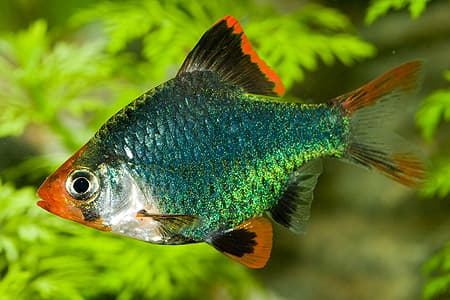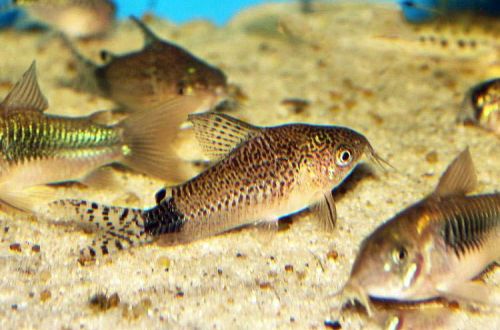
Green Barbus
The Green Barb is an artificial breeding form of the Sumatran Barb (Puntigrus tetrazona). An active schooling fish is very popular among aquarists for its bright color and ease of maintenance.

Brief information:
- The volume of the aquarium – from 50 liters.
- Temperature – 20-26°C
- Value pH — 6.0–8.0
- Water hardness – soft to medium hard (5-19 GH)
- Substrate type – sand
- Lighting – moderate
- Brackish water – no
- Water movement – moderate
- Size – up to 7 cm.
- Meals – any
- Life expectancy – 6 to 7 years
Contents
Description
The fish inherited a swift body shape – rounded, with a high dorsal fin and a pointed head. Appearance clearly indicates an active lifestyle. The color of the body has a rich green color with a blue metallic sheen. However, this coloration is typical only for young fish and with age it fades a little.

Unlike its predecessor, the Sumatran Barb, the Green Barb does not have a pronounced pattern of vertical dark stripes. The fins have a red border. During spawning, it becomes more saturated. In addition, in males, the head is painted in a bright red color.
Food
The fish happily accepts all types of live, frozen and dry food of suitable size. Small invertebrates such as daphnia, bloodworms, brine shrimp, etc. are good choices.
Maintenance and care
The Green Barb requires high water quality, which is easy to achieve by installing a powerful filter and renewing the water once a week for one quarter. The streams of water created by the filtration system cause an artificial current, which keeps the fish in good shape and does not interfere with them in any way.

Barbs live in the middle layers of the water, so decor items should be placed in sections to leave free places for swimming. Dense thickets of plants located along the walls of the aquarium will be an excellent shelter. It is recommended to use sandy soil with natural stained wood decoration elements (roots, branches, pieces of wood).
Behavior and Compatibility
Active friendly fish, compatible with other mobile species of comparable size. The content is flocking, at least 6-7 individuals. In a small group or singly, Barbs begin to show aggression towards their neighbors in the aquarium. The smaller the flock, the higher the degree of aggression. They also have another unpleasant feature – they bite and damage the fins of slow fish.
Breeding and reproduction
The fish reach puberty with a body length of about 2–3 cm. During the mating season, the male and female form a temporary pair, which is easy to distinguish in a flock, the female is larger with a full abdomen, the male is smaller, more intensely colored, and the head becomes bright red.
Spawning should take place in a separate tank of at least 40 liters, equipped with an airlift filter and a heater. In the design, several plants and soil from large pebbles are used. The water should be soft up to 10 GH, slightly acidic with a pH around 6.5 and a temperature of 24–26 °C.
The female is first transplanted into a separate tank. The male is planted only after two days. During the courtship dance, the female releases from 1 to 3 eggs at a time, which are immediately fertilized and sink to the bottom. In total, at least 300 eggs will be laid. After spawning, adult fish should be returned to the general aquarium so that they do not eat their own eggs. The fry appear after 2 days, and after another 5 days they begin to swim freely in the tank.
Fish diseases
In favorable conditions, diseases are quite rare. Health problems can be provoked by a decrease in water quality and the introduction of sick fish into a common aquarium. The symptoms and treatment methods are described in detail in the “Diseases of aquarium fish” section.





